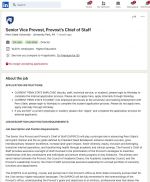See the link below. A few interesting excerpts from the article:
“UNIVERSITY PARK – During its first meeting of the Spring 2024 semester on Jan. 23, the Faculty Senate heard updates from Penn State leadership and engaged in conversation on the future of the University. They discussed the budget, a new business approach for remaining “great at scale,” and the recently announced academic program and portfolio review (APPR).“
***
“While the University has made significant progress in closing its budget deficit, Bendapudi said, it is still facing significant challenges, including changing demographics, increased operating costs and stagnant state funding.
In order to reach the goal of achieving a sustainable business model by the 2025-26 budget cycle, the next 18 months will be spent working alongside stakeholders, including Faculty Senate, to develop strategies that make sense for each individual unit and Penn State as a whole. That will include making investments in areas of potential growth within education and research.
This also means making decisions to divest from areas that are not as central to Penn State’s mission, according to Bendapudi, which means reducing the 2025-26 budget by $94 million, including a 14% reduction to the Commonwealth Campuses’ central budget allocation.
Faculty senators raised concerns, particularly regarding the announced budget cuts to the Commonwealth Campuses and asked how decisions will be made. Several senators voiced concerns about not feeling included in the decision-making process.”
***
”Included in the Jan. 22 update was the announcement that the University will begin an academic program and portfolio review (APPR) this semester of all academic programs, including undergraduate and graduate majors and minors offered at all campuses. This effort, which will be done in collaboration with Faculty Senate, is intended to determine how the University’s program offerings align with students’ desires and needs, as well as local, state and national employment trends…
…To guide this large and complex process and make sure it remains on track, Penn State will engage an outside consultant to provide objective support to the internal project team. In addition to Schwartz, that team also will be comprised of DelliCarpini, Faculty Senate Chair Michele Stine, as well as other faculty, staff and students who are still being named.
In response to faculty concerns about the outside consultant's role, Schwartz said the consultant will be gathering information and advising the internal working group and will not be making decisions. The request for proposal (RFP) process is underway to determine who the outside partner will be.”
***
”The University had a $57 million deficit in 2023, which was $89 million better than expected. That included $79 million more in revenue, which came primarily from investments, F&A and grants income, and $47 million in savings on the expense side, primarily from the strategic hiring freeze and other non-personnel savings.”
***
”Questions from faculty centered on Intercollegiate Athletics’ budget and whether any of that unit’s revenue could be used to supplement the education budget. Faculty referenced the $700 million Beaver Stadium project, which is being financed by debt.“
Leadering in all its glory.
“UNIVERSITY PARK – During its first meeting of the Spring 2024 semester on Jan. 23, the Faculty Senate heard updates from Penn State leadership and engaged in conversation on the future of the University. They discussed the budget, a new business approach for remaining “great at scale,” and the recently announced academic program and portfolio review (APPR).“
***
“While the University has made significant progress in closing its budget deficit, Bendapudi said, it is still facing significant challenges, including changing demographics, increased operating costs and stagnant state funding.
In order to reach the goal of achieving a sustainable business model by the 2025-26 budget cycle, the next 18 months will be spent working alongside stakeholders, including Faculty Senate, to develop strategies that make sense for each individual unit and Penn State as a whole. That will include making investments in areas of potential growth within education and research.
This also means making decisions to divest from areas that are not as central to Penn State’s mission, according to Bendapudi, which means reducing the 2025-26 budget by $94 million, including a 14% reduction to the Commonwealth Campuses’ central budget allocation.
Faculty senators raised concerns, particularly regarding the announced budget cuts to the Commonwealth Campuses and asked how decisions will be made. Several senators voiced concerns about not feeling included in the decision-making process.”
***
”Included in the Jan. 22 update was the announcement that the University will begin an academic program and portfolio review (APPR) this semester of all academic programs, including undergraduate and graduate majors and minors offered at all campuses. This effort, which will be done in collaboration with Faculty Senate, is intended to determine how the University’s program offerings align with students’ desires and needs, as well as local, state and national employment trends…
…To guide this large and complex process and make sure it remains on track, Penn State will engage an outside consultant to provide objective support to the internal project team. In addition to Schwartz, that team also will be comprised of DelliCarpini, Faculty Senate Chair Michele Stine, as well as other faculty, staff and students who are still being named.
In response to faculty concerns about the outside consultant's role, Schwartz said the consultant will be gathering information and advising the internal working group and will not be making decisions. The request for proposal (RFP) process is underway to determine who the outside partner will be.”
***
”The University had a $57 million deficit in 2023, which was $89 million better than expected. That included $79 million more in revenue, which came primarily from investments, F&A and grants income, and $47 million in savings on the expense side, primarily from the strategic hiring freeze and other non-personnel savings.”
***
”Questions from faculty centered on Intercollegiate Athletics’ budget and whether any of that unit’s revenue could be used to supplement the education budget. Faculty referenced the $700 million Beaver Stadium project, which is being financed by debt.“
Leadering in all its glory.




